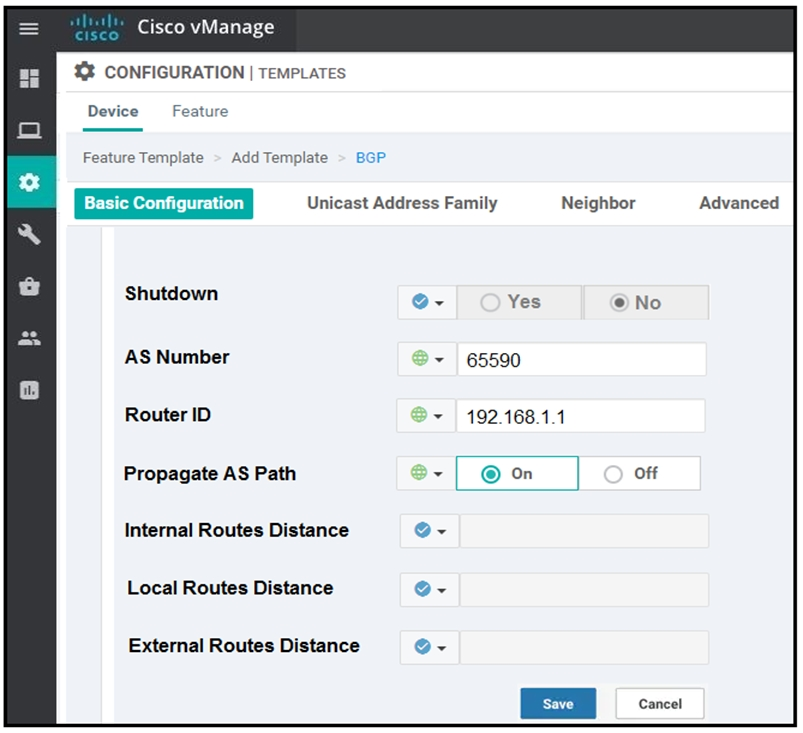
Refer to the exhibit. Which configuration value is used to change the administrative distance of iBGP routes to 20?

Refer to the exhibit. Which configuration value is used to change the administrative distance of iBGP routes to 20?
To change the administrative distance of iBGP routes to 20, you need to configure the Internal Routes Distance. Internal routes in this context refer to routes learned from other internal BGP neighbors within the same AS. The administrative distance configuration option provided for Internal Routes Distance allows you to set the administrative distance for such routes.
Answer A ist correct: internal Route-Distance = internal BGP Routes (Routes learned from a other internal BGP Neighbor - the same AS external Route-Distance: external BGP Routes (Routes learned from a other external BGP Neighbor - differnet AS Locla-Route Distance: Routes local on this Router redistributed into BGP (somthing like BGP Weight)
C is correct. Take a look at document and definition of those.
Cisco's parameter names are really stupid, but we have to accept them: External = received from the overlay tunnel Internal = not from overlay tunnel, eBGP Local = not from overlay tunnel, iBGP
Correct ans is C Local route
C. Local Routes Distance Specify the BGP route administrative distance for routes within the local AS. By default, a route received locally from BGP is preferred over a route received from OMP.
local routes distance is to change the AD of routes within the local AS
Internal Routes Distance Enter a value to apply as the BGP route administrative distance for routes coming from one AS into another. Range: 0 through 255 Default: 200 Local Routes Distance Specify the BGP route administrative distance for routes within the local AS. By default, a route received locally from BGP is preferred over a route received from OMP. Range: 0 through 255 Default: 200
nop, do not let the "internal routes" confuse you. the description says " - for routes coming from one AS into another-", if you recall your BGP, eBGP (external ) is from one AS to an other. if the routes are within the same AS , it is iBGP (internal routes). in vManage the description for local routes = iBGP
Agreed. Its clearly written in the document below : https://www.cisco.com/c/en/us/td/docs/routers/sdwan/configuration/routing/vEdge-20-x/routing-book/m-unicast-routing.html
local routes
nternal Routes Distance Enter a value to apply as the BGP route administrative distance for routes coming from one AS into another. Range: 0 through 255 Default: 200 Local Routes Distance Specify the BGP route administrative distance for routes within the local AS. By default, a route received locally from BGP is preferred over a route received from OMP. Range: 0 through 255 Default: 200 External Routes Distance Specify the BGP route administrative distance for routes learned from other sites in the overlay network. Range: 0 through 255 Default: 20
I would go for A, as they are internal BGP routes, received from another peer in same AS. Local I think are routes injected into BGP. The descriptions in the documentation is confusing and not clear.
I would go for A. Local routes means routes added via the network command under bgp process.
Answer is A. Configure Internal Routes Distance to 20 is correct
A. Configure Internal Routes Distance to 20.
I think C is correct Internal Routes Distance Enter a value to apply as the BGP route administrative distance for routes coming from one AS into another. Local Routes Distance Specify the BGP route administrative distance for routes within the local AS. External Routes Distance Specify the BGP route administrative distance for routes learned from other sites in the overlay network.
C is correct.
C is the correct answer here, NOT A. here is the reference document: https://www.cisco.com/c/en/us/td/docs/routers/sdwan/configuration/routing/ios-xe-17/routing-book-xe/m-unicast-routing.html summary of timtgh is correct.